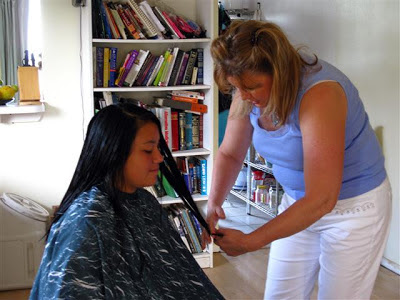A big part of this trip, apart from escaping the chilly gloom back home, was to see if Hawaii was a possible future home for us. Would we like it enough to live here, and if so could we afford it? Turns out the answer to both questions is “yes” - at least for the Big Island, where real estate is more affordable. (I'll get into more detail about costs in another blog post.) The next question is where specifically on this island would we want to make our home? Neither of us expected to be able to make that decision until toward the end of our trip after we had circled the island and exhaustively explored every community along the way. Much to our surprise, just three weeks into our trip, and after seeing only maybe a third of the island – albeit the most promising third – we have found our spot.
Hawi (pronounced huh-VEE) is a tiny town on the Kohala Peninsula at the north tip of the Big Island. It's commercial center is maybe three or four blocks long, with just the sort of boutiquey/artsy/bohemian vibe we like. Not posh, not run down, just right. There's a small grocery store, a post office, a few restaurants, art galleries, coffee shops, and places to buy vintage clothes, ice cream, and ukuleles. Hawi shows a nice sense of civic pride and volunteerism, and still feels a bit like “Old Hawaii.” It's right on the transition from the dry side of the island to the wet side. So it gets enough rain to keep it green, but not so much that you're fighting mildew. It's well located about a half hour from the islands best beaches, about an hour to the airport, an hour and a quarter to Costco and Kona, an hour and three quarters to Hilo. All doable. A mile or two down the road in the quaint neighboring town of Kapa'au is community park with a swimming pool, tennis courts, and gym – all free to use. There is even a small hospital. Further down the road is the Pololu Valley (see earlier post), a tourist draw that will benefit Deborah's plans to run a vacation rental & a skin care business.
So we're actively looking at properties in this area, realizing that our hopes to stay under $300K might leave us with a fixer. Some parts of the island are more expensive, some cheaper, but based on our experiences here, our conversations with many residents, my journeys here 18 years ago, and all the reading we've been doing more recently, this is where we want to end up. We have seen some houses that are possibilities, or we could end up buying land and building our own, or maybe we could find a way to stretch our budget. But whichever option we choose, it looks like it will be in Hawi/Kapa'au.
Here now are some pictures of Hawi buildings and, as I am famous for, not many people:
Just manger mannequins in the foreground of this shot - not real people.
Oops, a real person did sneak into this shot. 4 out of 5 isn't bad.



































